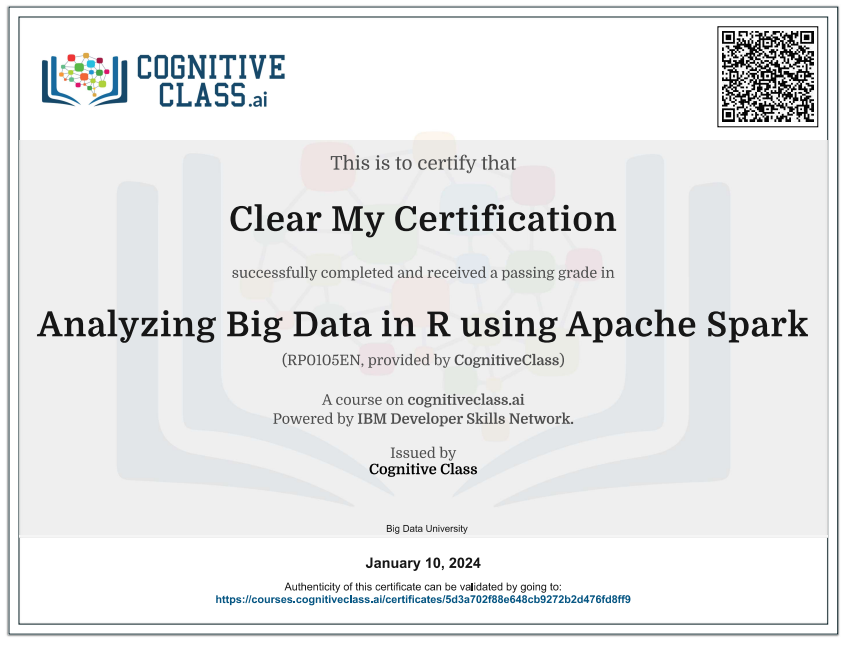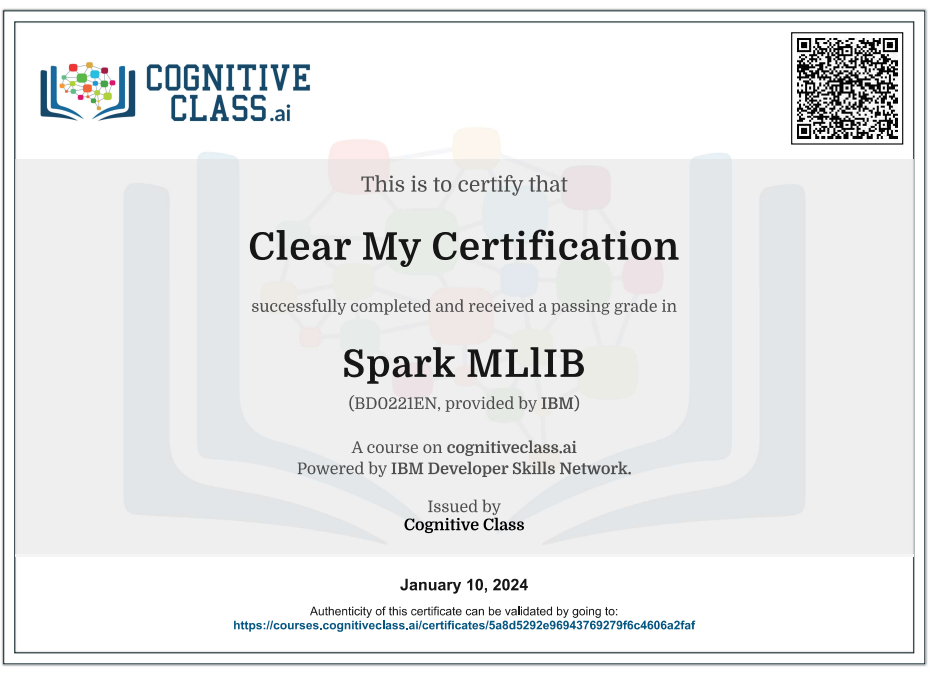Enroll Here: MapReduce and YARN Cognitive Class Exam Quiz Answers
MapReduce and YARN Cognitive Class Certification Answers

Module 1: Introduction to MapReduce and YARN Quiz Answers – Cognitive Class
Question 1: Which phase of MapReduce is optional?
- Shuffle
- Reduce
- Combiner
- Map
Question 2: Which node is responsible for assigning (key, value) pairs to different reducers?
- Shuffle node
- Reducer node
- Combiner node
- Mapper node
Question 3: Where are the output files of the Reducer task stored?
- A data warehouse
- Hadoop FS
- Within the Reducer node
- Linux FS
Module 2: Limitations of Hadoop v1 & MapReduce v1 Quiz Answers – Cognitive Class
Question 1: What is an issue or limitation of the original MapReduce v1 paradigm?
- It’s not scalable
- It only has one TaskTracker
- It only supports Parquet file types
- It only has one JobTracker
Question 2: How is YARN an improvement over the MapReduce v1 paradigm?
- It’s completely open source
- It splits the JobTracker into two processes: ResourceManager and ApplicationManager
- It reduces multi-tenancy to improve performance
- It splits the TaskTracker into two processes: ResourceManager and ApplicationManager
Question 3: Existing applications can run on YARN without recompilation. True or False?
- True
- False
Module 3: The Architecture of YARN Quiz Answers – Cognitive Class
Question 1: The main change from Hadoop v1 to Hadoop v2 was the consolidation of both resource management and job processing. True or False?
- True
- False
Question 2: The NodeManager is a more generic and efficient version of the TaskTracker. True or False?
- True
- False
Question 3: A new ApplicationMaster is launched for each job and ends when the job completes. True or False?
- True
- False
MapReduce and YARN Final Exam Answers – Cognitive Class
Question 1: Which of the following is the correct sequence of MapReduce flow?
- Reduce —> Combine —> Map
- Combine —> Reduce —> Map
- Map —> Reduce —> Combine
- Map —> Combine —> Reduce
Question 2: Which of the following can be used to control the number of part files in a MapReduce program’s output directory?
- Shuffle parameters
- Number of Reducers
- Counter
- Number of Mappers
Question 3: Which of the following operations will work improperly when using a Combiner?
- Average
- Maximum
- Count
- Minimum
Question 4: Which of the following is true about MapReduce?
- Compression of input files is optional.
- Output from the Map phase is replicated.
- The programmer must write the Map code, the Shuffle code, and the Reduce code.
- MapReduce programs must be written in Java.
Question 5: Input data to MapReduce is record-oriented and blocks of data contain the same number of full records. True or False?
- False.
- True.
Question 6: Which statement is true about the Reduce phase of MapReduce?
- Output results are sent to the client program.
- Data arrives from the Shuffle phase already sorted by key.
- The Reducer phase sums up the values associated with each key.
- Each Reduce task processes all the data for one key only.
Question 7: Which statement is true about the Reduce phase of MapReduce?
- Containers are used instead of slots in MRv1, and can be used with either Map or Reduce tasks in MRv2.
- There is one JobTracker in the cluster.
- MapReduce jobs written in Java for MRv1 never require recompilation.
- Each job has an ApplicationManager that obtains Container IDs from the NodeManager.
Question 8: With YARN, long-running jobs acquire and retain fixed-size containers before execution starts. True or False?
- False.
- True.
Question 9: Which of the following statements is true?
- The NameNode in Hadoop 2 is fully fault-tolerant, whereas in Hadoop 1 it was a single point of failure.
- The NodeManager in Hadoop 2 replaces the TaskTracker in Hadoop 1.
- YARN requires a minimum of two nodes, one master and one slave, to run
- Both MapReduce and YARN can scale to any cluster size
Question 10: The command athhadoop provides the CLASSPATH needed for compiling Java programs written for MapReduce or YARN. True or False?
- False.
- True.
Question 11: Which statement is true about MapReduce’s use of replication in HDFS?
- Only one copy of each replicated block is processed by MapReduce in normal operation.
- Speculative execution is normally performed on all copies of each “split.”
- Each DataNode uses RAID to store its data.
- Multiple copies of each record are kept on each node.
Question 12: On which file system (FS) is the output of a Mapper task stored?
- Linux FS, and it is replicated 3 times.
- HDFS, and it is replicated 3 times.
- Linux FS, but it is not replicated.
- HDFS, but it is not replicated.
Question 13: Which of the following statements is true?
- You can set the number of Reducers.
- The Shuffle phase is optional.
- You can set the number of Mappers and the number of Reducers.
- The number of Combiners is the same as the number of Reducers.
- You can set the number of Mappers
Question 14: What will a Hadoop job do if you try to run it with an output directory that is already present?
- It will create new files, but with a different suffix.
- It will create another directory to store the output.
- It will erase all files in that directory before running.
- It will not run.
Question 15: What are the main components of the ResourceManager in YARN? Select two.
- Scheduler
- JobTracker
- DataManager
- HDFS
- ApplicationManager
Introduction to MapReduce and YARN
MapReduce and YARN are key components in the Apache Hadoop ecosystem, designed to process and analyze large datasets in a distributed computing environment. Let’s explore each of them:
- MapReduce:
- Definition: MapReduce is a programming model and processing engine for handling large-scale data processing tasks in a parallel and distributed fashion.
- How it works:
- Map Phase: Input data is divided into smaller chunks, and a “Map” function processes each chunk independently to generate intermediate key-value pairs.
- Shuffle and Sort Phase: The intermediate data is shuffled and sorted based on keys to group related data together.
- Reduce Phase: The “Reduce” function processes each group of related data to produce the final output.
- Key Characteristics:
- Well-suited for batch processing of large-scale data.
- Fault-tolerant, as it can recover from node failures.
- Linear scalability, allowing it to scale horizontally by adding more nodes.
- Use Cases:
- Log processing, data warehousing, large-scale data analytics.
- YARN (Yet Another Resource Negotiator):
- Definition: YARN is a resource management layer that sits on top of Hadoop, allowing multiple data processing engines to share and allocate resources in a Hadoop cluster.
- How it works:
- YARN consists of a ResourceManager, which manages the overall allocation of resources, and NodeManagers, which run on individual cluster nodes to manage resources locally.
- Applications are submitted to YARN, and it allocates resources (CPU, memory) to run these applications in containers.
- Key Characteristics:
- Provides a more general and flexible resource management framework compared to the original Hadoop MapReduce.
- Supports various distributed computing frameworks beyond MapReduce, such as Apache Spark, Apache Flink, and others.
- Allows different applications to coexist and share resources in a multi-tenant environment.
- Use Cases:
- Enables running diverse workloads on a Hadoop cluster, including batch processing, interactive querying, and real-time analytics.
Together, MapReduce and YARN form a powerful combination for distributed data processing. While MapReduce is a specific model for batch processing, YARN serves as a resource management layer that allows Hadoop to support multiple processing frameworks, making the overall ecosystem more versatile and capable of handling various types of workloads. This flexibility has contributed to the continued evolution of the Hadoop ecosystem to meet the changing demands of big data processing.
 Clear My Certification All Certification Exam Answers
Clear My Certification All Certification Exam Answers



